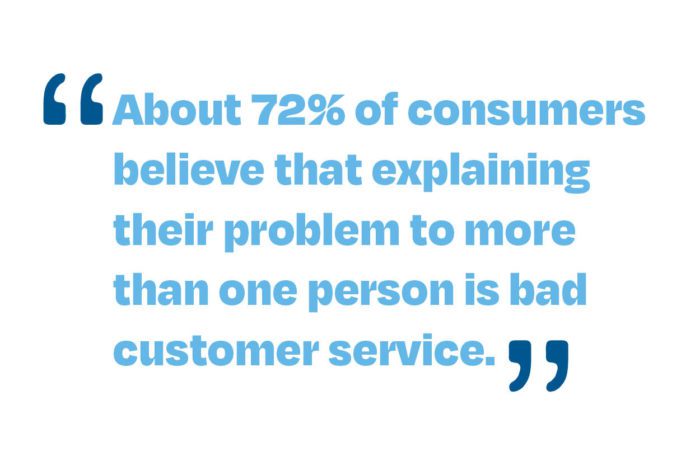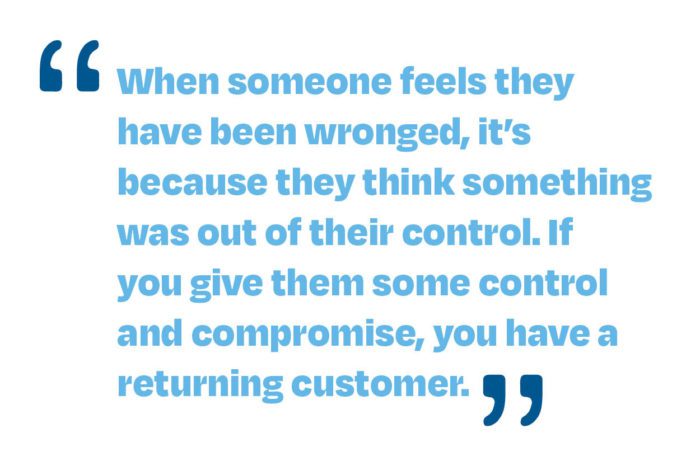We all know the golden rule: Treat others the same way you want to be treated. It’s a great way to go through life and not a bad basis for your business interactions. But is it enough to give your customers an outstanding experience? Or is there a customer service golden rule?

Yes, but I think there isn’t just one — there are 2.
Your customer service can either create a foundation for success or send your entire operation crumbling. It doesn’t matter how many sales you make if you can’t retain your customers with good service. You can have a great product, your marketing team can be the best in the business, and your location can be perfect, but when you don’t have an effective customer service plan to mitigate mistakes and find viable solutions, your business will fail.

Research backs this up. In fact, the average American tells 15 people when they have a bad customer service experience. In addition, 56% of worldwide consumers stopped using a business after one bad customer service experience. That’s a statistic you cannot afford to be a part of, especially since 67% of churn can be prevented if an issue is resolved when it first happens.
Customer service has no one-size-fits-all solution for every business, but we should all aim to meet certain standards — hence my golden rules. To demonstrate their importance, I want to share a story of a company that definitely did not have a customer service golden rule in mind.
A Painful (And Expensive) Typo
In 2011, Larina Helsom was experiencing severe chest pains. The condition grew to the point where she missed work and underwent surgery for muscle spasms to correct the issue. But what was causing her pain remained a mystery.
Then, Helsom noticed a small typo on her regular prescription. Her pharmacy was doling out 50 micrograms of medication for every dose she took, which was 10 times her prescribed limit! Helsom was overdosing on a regular basis because of an added zero.
Helsom contacted her pharmacy, and they argued that 50 micrograms was the standard dosage for this medication. Eventually, the pharmacy referred Helsom to a third-party customer service agency, which, according to studies, was a dangerous move on the pharmacy’s part. About 72% of consumers believe that explaining their problem to more than one person is bad customer service. In Helsom’s case, the move also lacked basic compassion for her extraordinary situation. Worse, the company ultimately stopped answering her calls.

As Helsom’s story spread, the pharmacy pledged to implement solutions to do better in the future. However, the pharmacy never released a public apology or record of compensation, leaving consumers and professionals scratching their heads.
So, What Went Wrong? And How Could It Have Gone Right?
Larina Helsom’s pharmacy failed to do right by the customer, and ultimately, they provided the public with a bleak non-resolution. Imagine making a mistake that caused someone to undergo surgery and not even saying you’re sorry! No one who read the story walked away feeling confident the pharmacy was sufficiently contrite for their actions or would take pains to avoid such a mistake again. Some readers probably swore off the pharmacy forever.
Helsom’s pharmacy obviously did not have a customer service golden rule in place when she went through her ordeal. The 2 I follow certainly would have been better than what Helsom’s pharmacy decided to do. While it’s not always easy, these rules have given my employees and me some guidance for correcting wrongdoings.
Customer Service Golden Rule No. 1: Politely Tell the Truth
This rule has two parts, but they go hand-in-hand. The first part of this Customer Service Golden Rule is that you must accept responsibility for your mistakes and be absolutely transparent. It’s not easy — most people who have worked with customers know the dread of needing to tell them about a critical error. You don’t know how they will react, and you can’t necessarily control it, but honesty is still the best policy.
After all, no customer wants to hear you drone on with excuses or be sent in 10 different directions as you pass the buck. So, you must be vigilant enough to (ideally) let the customer know you messed up before they discover it on their own. They won’t be happy that it happened, but they will value your honesty and straightforward communication.

As if admitting you screwed up wasn’t challenging enough, you must do it politely and accept the repercussions gracefully. It can be difficult to keep your temper at bay; when someone is yelling at you, the human impulse is to yell back or defend yourself. But that can’t be your response in a customer service scenario.
I always try to approach every conversation with ticked-off customers with an open mind and a positive attitude. To remain calm, it can help to take deep breaths, focus your responses on how you can help the customer now, and remember that the feedback usually isn’t personal. Here’s the bottom line: If you wouldn’t say it to your grandma, don’t say it to a customer.
Customer Service Golden Rule No. 2: The Customer Is Always Right (But Mistakes Are Rarely One-Sided)
Okay, not every customer is right — you know that. But you must show your customers that you’re willing to work with them, no matter what.
Active listening is essential. You’ve almost certainly spent time on the phone with a customer service agent who clearly doesn’t understand the problem you’re describing or keeps trying to fix the wrong issue. Isn’t it frustrating? You probably get more and more angry as time goes on and are more likely to resolve never to do business with a company again.
So, ensure you understand. After giving the customer time to say what they want to say, I start by paraphrasing the problem as they have told it to me to better understand the issue. Then, I allow the customer to correct any misconceptions. Sometimes they want to talk for a long time, and I let them. If we’re still at an impasse, I ask probing questions to help get to the heart of the matter.
Mistakes happen, so sometimes the customer’s problem truly is our fault — at which point, I go back to Customer Service Golden Rule No. 1. But sometimes, the customer is confused, is mistaken, or has unrealistic expectations. If I find there really wasn’t anything we could have done to prevent the mistake, I ask the customer questions about ways we can help, what the steps leading up to the problem were, and what we can do in the future.
It’s not easy telling a customer they’re wrong — it takes a lot of patience, tact, and finesse. But it’s part of the job, so having strategies ready to gently correct the customer while remaining willing to help is essential. You’ll never make everyone happy, but the right attitude can turn many negative interactions around.
Finally, I like to ask the customer what they think fair compensation would be. This puts them in the driver’s seat, which ultimately reduces frustration. When someone feels they have been wronged, it’s because they think something was out of their control. If you give them some control and compromise, you have a returning customer. Of course, you can’t blindly agree to every demand, but asking this question will help you understand their mindset and give you a starting place for your negotiations.

Implementing The Golden Rules
Knowing the Golden Rules is one thing; actually abiding by them is another. Let’s use Larina Helsom’s horrific experience as an example. How would applying these customer service golden rules have improved the situation?
Customer Service Golden Rule No. 1: Ideally, there would be a system in place that would ensure Helsom’s doctor’s recommendation for medication was followed by the pharmacy, but not every organization is the same. However, once Helsom found the mistake, her pharmacy was responsible for owning up to it and finding a way to correct it — without shuffling her problem around. Failing to answer the phone, directing her to other sources, and avoiding a formal apology isn’t how most people treat their grandmas.
Helsom’s pharmacy should have listened to her concerns, expressed empathy for her experience, and acknowledged that it was unacceptable. Instead of passing the buck to another department or company, the pharmacy should have designated the proper internal representative to research and manage the issue.
They also should have engaged in active follow-up rather than waiting for Helsom to call. And when she initiated the contact, they certainly should have answered! Finally, the matter never should have made its way to the news media before Helsom received an apology. Ideally, this expression of responsibility and regret should have come from someone influential and powerful within the company, not just her designated representative, due to the extraordinary scale of the issue. (In fact, if the pharmacy had apologized, the problem may have never become public at all.)
Customer Service Golden Rule No. 2: Sure, 50 micrograms may have been the standard prescription to measure out for this particular medication, but that doesn’t mean the pharmacy was right in giving Helsom 10 times her dosage. After she complained to the pharmacy, they had a duty to apologize and offer solutions, no matter what their “policy” states.

The pharmacy was right to request clarification on the matter, but they never should have argued with Helsom about her proper dosage or insisted they were right without a full investigation. They should have made sure they had all the facts straight first. And even if they were right, they should have used more tact in correcting the customer.
Next, they had a responsibility to make the situation right. In such an extreme scenario, that’s no easy task, but the pharmacy had an obligation to try. This might mean they call Helsom’s doctor, offer compensation, or work with her to find solutions. Allowing Helsom to express her feelings, share the impact of the error, and suggest how the pharmacy should resolve the issue would have gone a long way. Again, her resolution may not have been realistic, but the pharmacy should have heard it and worked with her.
No one wants to admit they were wrong, and developing the best practices for your customer service can take some work. But it’s well worth your effort! When you can own your mistakes politely and give your customers a fair compromise, you’ll find that the customers you wronged become your best customers. After all, it’s all about finding solutions, not being right.
Customer retention is one of the most important facets of your business strategy, but too many entrepreneurs neglect it while chasing after the next big thing. They forget that the most valuable customer is the one they already have. Newsletter Pro is dedicated to helping our clients keep their clients in the fold. Our Customer Retention Guide is full of expert tips to ensure your customers are happy and will return to you time and time again. Request your copy today!


Recent Comments